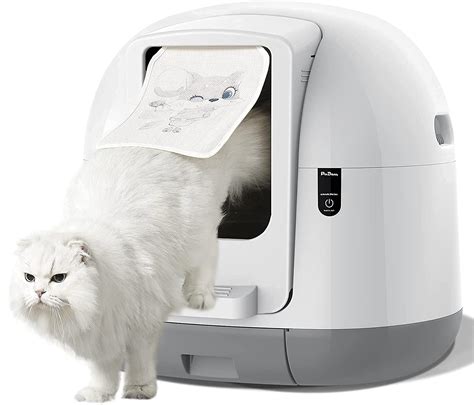Introduction: The Evolution of Robot Litter Boxes
In the realm of pet care, technology has taken a leap forward with the advent of robot litter boxes. These innovative devices offer a range of benefits, from automatic cleaning to odor control. However, understanding the optimal size and shape for your robot litter box is crucial for ensuring proper functionality and feline contentment.

Size Matters: How Big Should Your Robot Litter Box Be?
The size of your robot litter box depends on several factors, including the size of your cat and the frequency of cleaning cycles.
Size Recommendations
- Small Cats: 16″ x 12″ x 6″ (40 x 30 x 15 cm)
- Medium Cats: 20″ x 16″ x 8″ (50 x 40 x 20 cm)
- Large Cats: 24″ x 18″ x 10″ (60 x 45 x 25 cm)
Frequency of Cleaning
If you plan to clean the litter box every day, a smaller size may suffice. However, if you prefer longer intervals between cleanings, a larger box provides more space for waste accumulation.
Rule of Thumb:
Choose a litter box that is at least 1.5 times larger than your cat.
Shape Shifters: Exploring the Different Designs
Robot litter boxes come in various shapes, each with its advantages and disadvantages.
Rectangular:
- Most common shape, provides ample space for cats to move around.
- Can be placed against walls or in corners.
- May not be suitable for cats with mobility issues.
Triangle:
- Curve design reduces corner waste buildup, maximizing litter usage.
- Can fit in tight spaces.
- May not be as spacious as rectangular boxes.
Oval:
- Similar to rectangular boxes in shape, but with rounded edges.
- Facilitates easy cleaning and prevents litter spillage.
- May not be as stable as other shapes.
Tip:
Consider the physical abilities and preferences of your cat when choosing a shape.
Round vs Square: A Comparative Analysis
Round Litter Boxes
- Suitable for cats with mobility issues.
- Less corner space for waste accumulation.
- May not be as stable as square boxes.
Square Litter Boxes
- Ample space for cats to move around.
- Easy to clean and replace litter.
- Can be bulky and may not fit in tight spaces.
Verdict:
The best shape depends on the individual needs of your cat.
Step-by-Step Guide: Choosing the Perfect Size and Shape
- Assess Your Cat’s Size: Measure your cat’s length and height.
- Determine Cleaning Frequency: Consider the desired interval between cleanings.
- Explore Different Shapes: Review the advantages and disadvantages of rectangular, triangle, and oval boxes.
- Consider Mobility: Select a shape that accommodates the physical abilities of your cat.
- Make the Best Choice: Choose a litter box that meets your cat’s needs and preferences.
Pros and Cons: A Comprehensive Evaluation
Pros:
- Automatic cleaning saves time and effort.
- Odor control eliminates unpleasant smells.
- Health monitoring features track your cat’s health.
- Sleek designs complement modern home décor.
Cons:
- Higher upfront cost than traditional litter boxes.
- May require regular maintenance depending on the model.
- Some cats may be hesitant to use an automated litter box.
- Can be noisy during cleaning cycles.
Frequently Asked Questions
- How often should I clean the robot litter box? Most models require cleaning every 1-3 days, depending on usage.
- Can robot litter boxes work with all types of litter? No, some models are only compatible with specific types of litter, such as silica or crystal litter.
- Are robot litter boxes safe for my cat? Yes, robot litter boxes are generally safe for cats when used as directed.
- What are the benefits of using a robot litter box? Automatic cleaning, odor control, health monitoring, and convenience.
- How much do robot litter boxes cost? Prices can vary from $200 to over $1000, depending on features and brand.
- How do I choose the right robot litter box for my cat? Consider your cat’s size, cleaning frequency, physical abilities, and preferences.
Market Insights: Embracing the Future of Pet Care
The global robot litter box market is projected to reach $4.5 billion by 2025, with a CAGR of 12.5%. Increasing pet ownership, technological advancements, and growing awareness of pet health are driving market growth.
Case Study: Comparing the Litter-Robot 3 and the Catgenie
Litter-Robot 3:
- Capacity: 4 lbs (1.8 kg)
- Cleaning frequency: Daily
- Price: $499
- Pros: Self-cleaning, odor control, health monitoring.
- Cons: Requires emptying of waste drawer.
Catgenie:
- Capacity: 16 lbs (7.3 kg)
- Cleaning frequency: Weekly
- Price: $999
- Pros: Large capacity, fully automatic cleaning and disposal.
- Cons: Higher upfront cost, requires plumbing connection.
Conclusion:
Both the Litter-Robot 3 and Catgenie offer unique advantages. The Litter-Robot 3 is a more affordable option with daily cleaning, while the Catgenie provides larger capacity and fully hands-off cleaning.
Conclusion: The Purrfect Solution
Choosing the optimal size and shape for your robot litter box is essential for ensuring a positive experience for your furry friend. By considering factors such as your cat’s size, mobility, cleaning frequency, and preferences, you can select the perfect litter box to maintain a clean, odor-free, and healthy environment for your beloved feline companion.





















